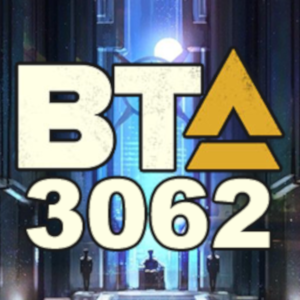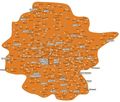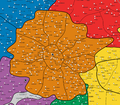Republic of the Sphere
This article needs to be updated with material from Jihad: Final Reckoning, Field Manual: 3085, Historical: Wars of the Republic Era, Turning Points: Epsilon Eridani, Technical Readout: 3145, Technical Readout: 3150, Shattered Fortress, IlClan (sourcebook), Hour of the Wolf, Rock of the Republic. Once these titles clear the Moratorium period, or if they already have, please consider revisiting this article and updating it with the new material. |
This article needs additional citations for verification. |
| Republic of the Sphere | |
|---|---|
| State Profile | |
| Founding Year | 3081 |
| Dissolution year: | 3151 |
| Capital world: | Terra |
| Controlled system(s): | 200+ |
| Government | |
| Head of State | Exarch |
| Civilian Intelligence | Sphere Intelligence Service |
| Military | |
| Army | Republic Armed Forces |
| Military Intelligence | Ghost Knights |
The Republic of the Sphere rose from the ashes of the Word of Blake Jihad. It was founded by Devlin Stone in 3081.[1] Its capital is the city of Geneva on Terra. Part of Stone's vision was to create a time of peace and the Republic helped fulfill that vision by occupying many of the planets that the Successor States had fought over for centuries. Stone also acknowledged that power came from the people, not the government, so he sought to weaken the power of the nobility. After a failed assassination attempt on both Wolf and Jade Falcon leaderships during their Battle on Terra, Devlin would concede to disband the Republic as an entity.
The estimated population of the Republic of the Sphere was 1.25 trillion.[citation needed]
The Republic's motto is Ad Securitas per Unitas, meaning "Liberty through Unity," with the Latin word "securitas" means not only "freedom" but "security," in acknowledgment of the violent past for which this region of space is famously known.[2]
History[edit]
Early formation[edit]
The Republic of the Sphere was born from the ashes of the Word of Blake Protectorate; negotiations between the leaders of all of the major powers from the Inner Sphere and Periphery (with the notable exception of the Capellan Confederation and the Magistracy of Canopus) gathered on Terra alongside the leaders of the allied coalition forces in December 3080 to discuss the formation of a new buffer state between the various Inner Sphere powers from the remains of the Protectorate. The various leaders left Terra on the 20th of December having reached a basic agreement that ceded the remains of the Protectorate to a new realm, the Republic of the Sphere.[3]
The Republic of the Sphere was officially signed into being between 7 and 15 March 3081, with all of the Great Houses save for House Liao signing the Republic Formation Treaty amidst a week of festivities. Each state except the Confederation recognized the Republic of the Sphere, with Devlin Stone as the first Exarch of the Republic.
The Capellan Confederation resisted Stone by military force until Chancellor Sun-Tzu Liao was brought to the negotiating table and encouraged to sign the Tikonov Treaty of 3085.[4]
There were two social programs that would become historically significant to the Republic and Stone himself:
- The Resettlement Act of 3082, in which through various incentive programs tried to mix the variety of cultures that existed within the Republic's claimed space, erasing old hatreds and biases by resettling key elements of the population from one world throughout the towns and cities of several others. The program took decades, but brought about the end of the factionalism so often thought responsible for outbreaks of war within the Inner Sphere.[5]
- The Military Materiel Redemption Program, which grew out of the Citizenship Priority Decree of 3083. This plan worked to decommission BattleMechs and other tools of warfare, downsizing armies and removing any such matériel from the hands of private individuals, in exchange for the rights of citizenship and other socioeconomic incentives.[5]
Exarch Devlin Stone called the first Senate meeting to order on Terra in 3085 and officially formed the Knights of the Sphere in 3088. By 3091, the hierarchy of government was firmly in place with Prefecture borders settled and most world governments toeing the line to create an enviable state among the Inner Sphere nations.[5]
Middle years[edit]
Everything was more or less okay until 3104, when an internal struggle within the Capellan Confederation spilled over the border and Exarch Stone was eventually forced to send Republic troops into the Capellan territories. These sporadic conflicts plagued Stone for nearly a decade, until the peace efforts of 3113 finally stabilized the region.[5]
Gray Monday, rise of Splinter Groups, and invasions[edit]
After the fall of the HPG grid in 3132, in the Blackout, The Republic was torn apart by warring factions within the government who supported neighboring nations including the Draconis Combine, Federated Suns, and Lyran Commonwealth. The chaos caused by the blackout also led others like Clan Jade Falcon, the Oriente Protectorate, and the Capellan Confederation to believe that the fragmented, stumbling Republic made an easy target, so they invaded.[3] The Combine launched a raid of its own in 3133.[6]
Civil War[edit]
After fighting off the various invasions, the Senate tried to achieve a coup over the ruling Paladins through subversion. Led by Senator Geoffrey Mallowes of Skye, the Senate sponsored promising military officers. The plan was for these officers to be successful in becoming knights and even paladins, then, remembering who initially supported them, return some measure of power to the Senators. This plot was uncovered by Paladin Victor Steiner-Davion, who paid for the discovery of that knowledge with his life.
In response, newly elected Exarch Jonah Levin dissolved the Senate, touching off a civil war on Terra and beyond. In one engagement, a pair of RAF Roadrunners, one piloted by Captain Sage Rivers, were assigned the role of tracking down Senatorial forces who were attempting to flee Terra. They came upon a damaged Night Stalker attempting to flee but Rivers was able to maximize his advantages and destroyed his opponent with a rear hit to the gyro.[7] The Senate loyalists were ultimately driven off, thanks in part to the Republic's new ally, the Federated Suns. Individual Senators retreated to their homeworlds, but most found that they lacked the support needed to build the kind of coalition they desired. This would result in a number of worlds forming their own small nation known formerly known as the Senatorial Alliance.[8]
Fortress Republic[edit]
Due to all of the turmoil, many of the Knights and much of the Armed Forces of the Republic retreated back to Prefecture X under the plan code named "Fortress Republic." Exarch Levin dissolved the Republic and claimed a newly declared region of space encompassing only slightly more than Prefecture X. This area of space severed all ties with all worlds outside of the territory, even with other worlds of the Republic. Levin stated that he would use all the forces at his disposal to ensure that the newly drawn boundary remained inviolate. The Republic dissolved as a major political body after the Fortress declaration and was renamed the Republic Remnant or "Republic Territories."
While behind the Walls of the Republic, the Republic forces inside would hunt down and destroy remaining splinter factions and Senate Alliance forces cut off behind the Fortress' walls. Among the first and most notable of these test for the newly formed combat units, would be to hunt down the renegade ComStar's elements that had re-formed the Com Guards under the name of Buhl’s Blessed Order. Elements of the Republic forces would end up pursuing ComStar forces to their hidden outpost on Epsilon Eridani and destroying them on their last stronghold in 3141.[9]
Disbandment[edit]
Hoping to end the fighting between Clan Wolf, Devlin would contact Alaric to discuss terms of surrender, but due to his attack on both him and Malvina, he would bring her in as well to the dismay of the Exarch. Devlin would meet both Alaric and Malvina in person to discuss the terms of his surrender, however both Khans were not pleased. Instead Alaric would insist on his own alternative, the disbandment of the Republic of the Sphere. Though reluctant to do so, the Exarch would comply. Devlin Stone would broadcast the disbanding of his empire, thus ending the Republic as an entity.[10]
Government[edit]
Executive[edit]
Exarch[edit]
The Republic is ruled by an Exarch, elected by the Council of Paladins from within its own ranks. An Exarch serves a four-year term and, though multiple terms are allowed, they may not be consecutively served. This position is both the chief executive of the realm and the supreme commander of the Republic Armed Forces.[11]
The Council of Paladins[edit]
The name of the body given to the seventeen Paladins chosen by the Exarch to serve as his advisory council. The responsibility of the Paladins was to ensure that day-to-day operations of the Republic were running smoothly and without internal conflicts. These duties could include overseeing local elections, trade negotiations between planets, investigations into high-level criminal activities, developing strategies and aiding in defusing potential crises, and/or act as arbiters in disputes. Though a Paladin must be prepared for any sort of situation, many of them chose to stay within specific areas of expertise. Paladins are chosen from the ranks of the Knights as a candidate when a slot becomes available, through retirement, promotion to Exarch, or death.[11]
Knights[edit]
Knights are individuals who have been recognized by the government of the Republic as highly skilled and intelligent individuals who have set aside their own needs for that of the Republic and its people. David Lear helped establish the knights using the title to promote a model of behavior for people to look up to.
They are the immediate agents of the Paladins and Exarch’s executive branch, usually acting as aides, military liaisons to local militia commanders or commanders themselves.
Knights are not necessarily military personnel, though it is the most common avenue. Other Knights include scientists, businessmen, artists and other professions. In addition to their title, Knights are also entitled to land grants. They are also referred to by title "Sir" or "Lady."
Another branch in the Knights Corps are the Ghost Knights. They are the elite of the clandestine Republic Intelligence community. They work in the shadows, with very few individuals actually knowing their true identity. They are more than just spies, they are special operations troops able to operate combat vehicles, BattleMechs and so forth whenever the mission requires. They work for a select group of Knights and Paladins and not directly with Republic Intelligence.[12] The Ghost Knight's leading commander is only known as the Ghost Paladin.
There are two ranks of seniority for the "Knight" in the Republic of the Sphere. Knights-Errant are basically entry level Knights. Their uniforms are gray tunics and black trousers chased with scarlet and gold piping with their name monogrammed on their left breast.[13] The uniform of a Knight differs in that they wear steel gray tunics with scarlet piping, a gold shield on each arm and the cape of rank falling down to the back of their knees.
Legislative[edit]
Senate[edit]
The Republic Senate was a body of thirty to forty individuals that oversees the political aspects of the federal government.
The Senate dealt with any issues that cross Prefecture boundaries and served as an oversight committee for all Governors, making sure the power of that office was not abused. From three to four Senators were elected by the citizens of each Prefecture. Those individuals were always from the nobility, except on Clan populated worlds, where a Trial of Position was taken. A Senator would serve until he was voted out. Even Knights of the Sphere could be elected to the Senate, but on those instances, the Knight must gave up all his powers and responsibilities within the Knights of the Sphere for the duration of his term. Once this Knight leaves the Senate, and provided he passed the required tests, he could reenter the Knights of the Sphere.[14]
Though the name of the Republic would seem to imply that the Senate would be a very powerful institution, it was not. The Senate's powers were largely advisory. Each world sent two noble representatives to Geneva.
Devlin Stone wanted to break down the barriers that shielded the nation's leader from his or her people. This meant getting rid of the hereditary nobility. Stone, however, realized that he needed their support to make the Republic work. He created the Senate to appeal to the nobility, but gave it and them no real power. The Senate attempted a long-term power play that was discovered by the Paladins in 3134. In response, newly elected Exarch Jonah Levin dissolved the Senate.
In retaliation, the senators rebelled against the Republic, trying to seize the control and capture the other heads of state of all states in the Inner Sphere, who were on Terra to assist the Funeral of Victor, but they failed. Defeated repeatedly, they eventually formed their own state: the Senate Alliance.
Prefectures[edit]
Each world has a single Governor, whose term of Governorship is for life and can only be stripped by the Senate, though if a Governor accepts a seat on the Senate, he must voluntarily give up his Governorship.[15]
Continuing down the ruling structure of the Republic, every Prefecture is ruled by a Lord Governor who was elected by the Governors of that Prefecture and that serves a ten-year term.[15]
A Prefect is a military leader selected by the Paladins and that serves for five years. Their choice can only be overruled by the Exarch.[15]
In each world, all military matters are handled by a Legate, who is appointed by the Governor, and that oversees planetary security and any martial issue on the planet. There is not a predefined length of time a Legate can serve. All Legates answer to a single Prefect.[15]
The Republic consists of ten prefectures, using roman numerical system of numbering.
- Prefecture I, Prefecture II, Prefecture III, Prefecture IV, Prefecture V, Prefecture VI, Prefecture VII, Prefecture VIII, Prefecture IX, Prefecture X.
Military[edit]
The disarmament of the Republic territory was almost total: beyond the few military units, or the Knights, very few persons got BattleMechs. On every planet was a local militia, with infantry, armor and even artillery... but only one BattleMech On the majority of planets. But not always: On Mirach, the only BattleMech, the Governor's Centurion, was exposed in a museum. Other planets, like Achernar, got two 'Mechs, and others more.
In 3135, the Republic Armed Forces are commanded by Commanding General Tina Magnusson-Talbot. Each Prefecture contains three combined arms regiments: an elite Hastati Sentinels, a veteran Principes Guards, and a green parade unit, the Triarii Protectors. Each one is named after a different type of Roman infantry. The Hastati were light infantry, the Principes the heavier veterans, and oddly the Triarii the grizzled elites. Each of the thirty regiments is named by the prefecture they operate in, e.g. III Triarii Protectors is in Prefecture III.
In addition to the Regular Army, the Republic maintains other units. The most prominent of these is the Northwind Highlanders. A prestigious unit with a history that dates back to pre-spaceflight Scotland on Terra, the Highlanders have been very active in the Republic since the fall of the HPG network. Even though they are based on Northwind, the Highlanders have been active throughout the Republic.
A group of individuals rather than a true military unit, the Corps of Knights is composed of some of the finest MechWarriors in the Inner Sphere. Knights are commanders who are essentially troubleshooters and occupy a unique position in the military hierarchy. Knights are generally assigned specific tasks or as commanders of ad hoc units, rather than being permanently assigned to a unit. Since knighthood is a prerequisite to becoming a paladin, many ambitious individuals seek to become knights.
A third special force, the Fidelis (publicly known as Stone's Shadows) are a mysterious and secretive group. They were used by Devlin Stone during his anti-Jihad campaigns as elite guards and black ops. Only the Exarch has the power to call upon the Fidelis, who serve a blood oath to the Republic. In the 3130s, the Fidelis are still led by their Custos, more than a century old. They are an amalgamation of elite troopers and black ops commandos. Each warrior is cross-trained in many specialties so that an infantryman can easily take to the cockpit of a 'Mech and pilot it. Their infantry forces are far superior to any others, with a squad of seven able to take down a BattleMech.
Map Gallery[edit]
Notes[edit]
- During the period between the capture or liberation of Terra in 3079 and the final fall of the Word of Blake, the region which had been known as the Word of Blake Protectorate appears to have been referred to as the "Terran Protectorate" prior to the formation of the Republic of the Sphere.[16][17]
- The Latin securitas does not mean "freedom" as in "personal liberties"; securitas means "security" or "safety." Some translations mention "freedom from care." The phrase "Ad securitas per unitas" means "to security through unity."[citation needed]
References[edit]
- ↑ History: The Republic of the Sphere[citation needed]
- ↑ Dark Age: Republic of the Sphere, p. 1: "The Republic of the Sphere"
- ↑ 3.0 3.1 Jihad: Final Reckoning, p. 61: "The Jihad in Review"
- ↑ Dark Age: Republic of the Sphere, p. 1: "Advocates for the Republic"
- ↑ 5.0 5.1 5.2 5.3 Dark Age: Republic of the Sphere, p. 27: "Devlin Stone"
- ↑ BattleTech: 25 Years of Art & Fiction
- ↑ Technical Readout: 3150, p. 122
- ↑ Field Manual: 3145, pp. 19, 22, 135: Senate Rebellion information from FM: 3145
- ↑ Field Manual: 3145, pp. 135–138: Republic's forces history in Fortress Walls, Origin of the technology of the Fortress, hunt for the renegade ComStar Forces
- ↑ Hour of the Wolf, pp. 346–352
- ↑ 11.0 11.1 Field Manual: 3085, pp. 164–165: "Power to the People"
- ↑ Flight of the Falcon, p. 287
- ↑ Sword of Sedition, p. 83
- ↑ Dark Age: Republic of the Sphere, p. 3: "The Senate"
- ↑ 15.0 15.1 15.2 15.3 Dark Age: Republic of the Sphere, p. 4: "Structure and Local Government"
- ↑ Jihad: Final Reckoning, p. 20: "Bloody Tricentennial"
- ↑ Jihad: Final Reckoning, pp. 25–26: "Historic Trade Pact Normalizes Relations for Andurien, Canopus, Sian"
Bibliography[edit]
- Blood of the Isle (novel)
- By Temptations and By War (novel)
- A Call to Arms (novel)
- Daughter of the Dragon (novel)
- Dark Age: Republic of the Sphere
- Dragon Rising (novel)
- Flight of the Falcon (novel)
- Fortress of Lies (novel)
- Fortress Republic (novel)
- Ghost War (novel)
- Hunters of the Deep (novel)
- Jihad: Final Reckoning
- Masters of War (novel)
- The Republic of the Sphere on LinkNet (archived)
- The Ruins of Power (novel)
- The Scorpion Jar (novel)
- Service for the Dead (novel)
- A Silence in the Heavens (novel)
- Surrender Your Dreams (novel)
- Sword of Sedition (novel)
- Target of Opportunity (novel)
- Trial by Chaos (novel)
- Truth and Shadows (novel)







